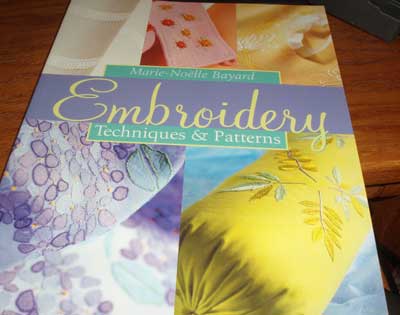Sometimes, I come across embroidery books in weird ways. I asked the other day for recommendations for beginner embroidery books for youth, ages 15 or under, with a price limit of $15. I got some good suggestions, and in looking some of the suggestions up, I came across a neat book that I wanted to review in case it could fit the bill for some readers who are just getting into embroidery, or for those who want some interesting, planned projects.
The book is called Embroidery Techniques and Patterns. It’s written by Marie-Noelle Bayard. I really like it! I wish, in fact, I had come across it sooner, as I have had several friends ask for recommendations, and the types of projects in Marie-Noelle’s book are right up their alley!

The book begins with good instructions on getting started in embroidery: materials, preparation, and so forth. It is then divided into types of stitches, which are then broken down into stitch “families” within the types. Within each section on types of stitches, the author gives instructions on how to complete various projects which are pictured in the book.

So, for example, under filling stitches (types of stitches), she has Ceylon, cross stitch and variations, satin stitch, and so forth.

The types of projects presented in the book range for useful household decor – pillows, curtains (Really Beautiful Drawn Thread Curtains), picture frames, and so forth – to pretty wardrobe accessories (purses and stoles) – to practical needlework accessories (pincushions) – to family holiday items (like a reindeer Advent calendar). They are tasteful projects accessible to the beginner.

The stitch directions in the book are step-by-step photographs, which is really handy for the beginner.

And the patterns for the projects are clear line drawings that can be photocopied and enlarged or traced as is.
The book also features a picture index of the stitches, which I love to see in how-to embroidery books!
The pros of the book: 1. it’s comprehensive – stitch directions, projects, finishing tips, etc., are all available inside the covers of the book; 2. the stitch directions are clear and there are plenty of them; 3. the projects are tasteful; 4. the book is attractive; 5. the price is right – under $11 through Amazon for a very nice book – you get a lot of instruction and inspiration for the price!
The cons: 1. it’s a heavy book, making it difficult to use while actually stitching; 2. the binding is typical paper-back glue binding, which, coupled with the weight of the book, makes it even more difficult to use while stitching – a spiral binding would have been much more effective. But those are really the only two draw-backs I can see to it, and they aren’t major. The book does lay open on the table, so you wouldn’t really have any problem stitching, even if it isn’t quite as convenient as a spiral binding is on a how-to book.
I’m really glad I came across this little gem. I think it will be perfect for those who want “something to embroider” that would look good used in the home or on the person, but who don’t want anything too complex or expensive as far as supplies go.
Age-wise, I’d say it would be a good book for beginners, age 15 and up.
So, if you’re looking for a nice how-to book that has a lot in it for the price, do check out Marie-Noelle Bayard’s Embroidery Techniques and Patterns! I think you’ll like it!







I’ve started taking my paper-back glue bound books to have the spines cut off and then spiral bound. It’s usually under 5$, and makes the book enough easier to use that it’s worth the extra expense!
That is an EXCELLENT idea, Kim! Thank you for the tip!
Mary, or anyone who might be familiar with both of the following books? If you were in the process of trying to design and create a sampler for yourself, which of these titles might you buy as a source of inspiration and information? – “Stitch Sampler: The Ultimate Visual Dictionary to Over 200 Classic Stitches”, by Lucinda Ganderton? Or ”Mary Thomas’s Dictionary of Embroidery Stitches”, by Mary Thomas?
Just looking at the covers, I’m leaning toward “Stitch Sampler…” because it appears to be, as it says right in the title, devoted to exactly what it is I’m looking to do. Also, the photos from it, that I’m able to see on Amazon, show nice, clear close ups of various stitches.
But maybe Thomas’s Dictionary is just as good or better at showing off various stitches. I don’t know! Thanks for any opinions offered! – Jeannine
Hi, Jeannine –
I have both books, and I like both of them. I’ve reviewed Mary Thomas’s book here:
Mary Thomas’s Dictionary of Embroidery Stitches
Either one are good, and in fact, they’re both very much the same. The Stitch Sampler book may have more stitches in it, but they’re pretty much both stitch dictionaries, with diagrams of the various stitches.
You are my embroidery angel, Mary. 🙂 Thanks a million! – Jeannine